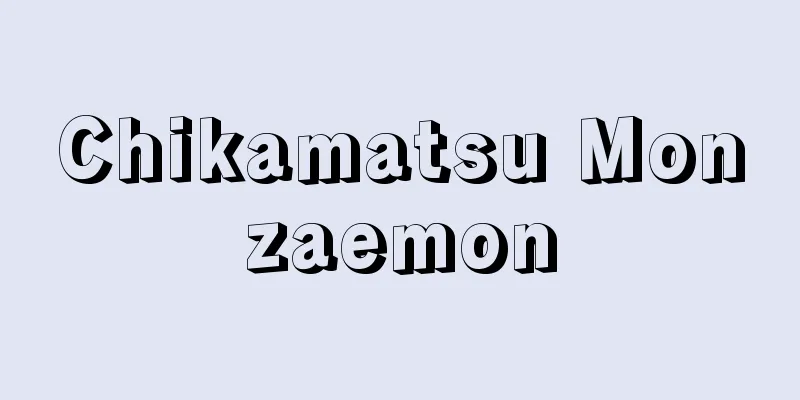Chikamatsu Monzaemon

|
A Joruri and Kabuki playwright from the early Edo period. His real name was Sugimori Nobumori. He was commonly known as Heima. His other names were Heiando, Sorinshi, and Fuisanjin. He was born in Fukui in 1242 as the second son of Sugimori Nobuyoshi, a samurai of Yoshie Domain in Echizen. However, when his father became a ronin, Chikamatsu moved to Kyoto with his family when he was about 15 or 16 years old, and served the Ichijo Ekan family (also known as the Ogimachi family or Ano family), a nobleman. When he was 20 years old, he resigned from his master after his death. His whereabouts after that until he became a writer are unclear, but he once studied at the Gonsho Temple in Miidera Takakannon in Omi Province (Shiga Prefecture), and some say he took on the pen name "Chikamatsu Monzaemon" as a result of this connection, but the truth of this is unclear. It is believed that he studied Japanese and Chinese classics during that time and also acquired knowledge of Buddhism. It seems that by around the age of 25 in 1677 (Enpo 5), he had become a Joruri writer under Uji Kaga no Jo in Kyoto. For a man of samurai descent, it was a bold move at the time to enter the world of performing arts, which was looked down upon, but it turned out to be a blessing in disguise. Over the next 40 years until his death at the age of 72, he wrote over 30 Kabuki scripts, over 80 Jidai Joruri pieces, and 24 Sewa Joruri pieces, leaving behind a brilliant legacy that earned him the acclaim of being Japan's greatest dramatic poet. His career as an artist can be roughly divided into four periods. [Jiro Yamamoto] 1st PeriodThis period was from when he became a Joruri composer until 1692 (Genroku 5), when he was about 40 years old, and was a period of study. He wrote over a dozen old Joruri pieces, such as "Iroha Monogatari," "Akazomeemon Eiga Monogatari," and "Yotsugisoga," which are thought to have been written for Kaga no Jo, and "Shuse Kagekiyo," "Tenji Tenno," and "Semimaru," which he wrote for Takemoto Gidayu. Among them, "Shuse Kagekiyo," written in 1685 (Jokyo 2), was a groundbreaking work that breathed fresh air into traditional Joruri, dividing the history of Joruri into old and new, and the work before this came to be called old Joruri, and the work after this came to be called new Joruri. However, at this time, Chikamatsu lived a difficult life financially, making a living by repairing props at the Miyako Mandayu theater and as a lecturer in Sakai. [Jiro Yamamoto] Second PeriodThis was the period from 1693, when he was 41 years old, to 1703, when he was around 51 years old, during which he mainly wrote Kabuki Kyogen plays. It is said that Chikamatsu trained as a Kabuki playwright at the Miyako Mandayu-za Theatre in Kyoto from around the beginning of the Jokyo era (1684-88), but from around 1693 he mainly wrote Kabuki Kyogen plays for the famous actor Sakata Tojuro. He wrote works such as "Butsumomo Maya Sankaicho," "Yugiri Nanenki," "Daimyo Nagusami Soga," "Isshin Niga Byakudo," "Keisei Hotoke no Hara," and "Keisei Mibu Dainenbutsu," laying the foundation for the rise of Kabuki in the Genroku period. These generally dealt with the world of family feuds and incorporated tales of divine intervention, but at their core were realistic portrayals of scenes from the pleasure quarters of the brothels, featuring the services of courtesans and courtesans. His experience with Kabuki, which is far more modern than Joruri, was of great help in founding Sewa Joruri. [Jiro Yamamoto] Third PeriodThis was the period centered on sewa joruri, from when he wrote his first sewa joruri, "Sonezaki Shinju" in 1703 at the age of 51, to when Gidayu (Chikugo no Jo) died in 1714 (4th Shotoku) at around the age of 62. Sonezaki Shinju was performed in various kabuki productions immediately after the incident, but Chikamatsu brought it into puppet theater, founding the sewa joruri genre. The performance of this work was a great success, and the Takemotoza was able to pay off all its debts in one go. Taking this opportunity, Chikugo no Jo eventually handed over his position as zamoto to Takeda Izumo, but continued to work as a tayu, and Chikamatsu became the resident playwright for the Takemotoza and devoted himself to joruri. During this period, 16 sewa joruri pieces were created, such as "Horikawa Namino Tsuzumi," "50th Anniversary Memorial Song Nembutsu," "Love Suicides: Shigeizutsu," "Love Suicides: Mannensou," "Tamba Yosaku Matsuyo no Komuro Bushi," "Meido no Hikyaku," and "Yugiri Awa no Naruto," as well as period joruri pieces such as "Yomei Tenno Shokunin Kagami," "Kyosei Hangonko," "Goban Taiheiki," and "Komochiyamanba." The establishment of sewa joruri is of great significance, as it led to the complexity and variety of joruri that followed. [Jiro Yamamoto] 4th PeriodIn his later years, when he had reached the peak of his maturity, he encouraged Takemoto Masatayu (the second Gidayu) and displayed his prowess in writing. With the death of Chikugonojo in 1714, the Takemoto-za faced a crisis, but the following year he wrote "Kokusen-ya Kassen" (The Battle of Kokusenya), incorporating the opinions of the head of the za, Izumo, which became a huge hit after three years and 17 months, and the za's business was put on hold. After that, Chikamatsu's writing became increasingly mature, and he left behind masterpieces such as "The Beginning of Japanese Long-sleeved Kimono," "The Heike's Nyogo Island," and "The Battle of Kawanakajima in Shinshu" in period joruri, and "The Great Suicide Master's Old Calendar," "The Three Layers of the Spear's Curtain," "The New Year's Pillow of Yamazaki Yojibei," "Hakata Kojoro Namimakura," "Single Suicide on Heavenly Amijima," "Woman Killing in Oil Hell," and "Single Suicide on the Night of the Monkey." He died on November 22nd of the same year at the age of 72, with "Kanhasshu Tsunagiuma" (Horse-linked Horses of the Kanto Region), which was performed in January of the 9th year of the Kyoho era, as his last work. His grave is at Kosai-ji Temple in Amagasaki City, and the Chikamatsu Memorial Museum is also located there. His grave remains at the site of Homyo-ji Temple (the family temple of his wife's family) in Chuo Ward, Osaka City. Chikamatsu perfected Joruri by adapting old Joruri to a modern style, but in Jidai Joruri he skillfully blended romantic and realistic elements into the original dreaminess, and in Sewa Joruri he vividly and lovingly portrayed the lives of ordinary people living in the conflict between duty and human feelings, moving people's hearts. Many of his works deeply pursue unchanging humanity, and many of them continue to have a modern life. The fact that his ideas, ideas, and writing have had a great influence on later plays also speaks to his greatness. However, highly performed works such as Meido no Hikyaku and Shinju Ten no Amijima were only performed as they were in the original at the premiere, and after that, revised versions that were often involved in later works were put on the stage. This is thought to be because there were more flashy and theatrical works after Chikamatsu, and the adaptations were made in response to this. After World War II, calls for a reexamination of Chikamatsu arose, and performances of the original works have increased. Furthermore, Chikamatsu's view of art, which can be found in Hozumi Koretsura's Naniwa Miyage (Souvenirs from Naniwa), that "art lies between the thin membrane of falsehood and truth," is famous for revealing his attitude toward theater. [Jiro Yamamoto] "The Complete Works of Chikamatsu," 12 volumes (1925-28, Osaka Asahi Shimbun)" ▽ "The Complete Works of Chikamatsu Kabuki and Kyogen," 2 volumes (1927, Rokugokan)" ▽ "The Complete Series of Japanese Classical Literature, 49 and 50, The Chikamatsu Joruri Collection, Volumes 1 and 2 (1958, 1959, Iwanami Shoten)" ▽ "The Complete Works of Japanese Classical Literature, 43 and 44, The Chikamatsu Monzaemon Collection" (1972, 1975, Shogakukan)" ▽ "The Chikamatsu Sewamono Collection, translated and annotated by Morizui Kenji (1976, Obunsha)" ▽ "Prologue to Chikamatsu, by Hirosue Tamotsu (1957, Miraisha)" ▽ "Chikamatsu Monzaemon, by Kawatake Shigetoshi (1958, Yoshikawa Kobunkan)" ▽ "The Complete History of Research on the Japanese Language and Literature, Volume 10, Chikamatsu" (1964, Sanseido)" ▽ "Study of Chikamatsu by Shige Tomotake (1972, Bunri Shoin)" ▽ "Study of Chikamatsu Sewa Joruri by Suwa Haruo (1974, Kasama Shoin)" [Chronology] |Written by Chikamatsu Monzaemon ( Owned by the National Diet Library ) "Kyosei Hangonko" Written by Chikamatsu Monzaemon, published in 1720 (Kyoho 5), held at the National Diet Library "The Love Suicide of Ten no Amijima" Source: Shogakukan Encyclopedia Nipponica About Encyclopedia Nipponica Information | Legend |
|
江戸前期の浄瑠璃(じょうるり)・歌舞伎(かぶき)作者。本名杉森信盛(のぶもり)。通称平馬。別号は平安堂、巣林子(そうりんし)、不移(ふい)山人。承応(じょうおう)2年越前(えちぜん)吉江藩士杉森信義(のぶよし)の二男として福井に生まれたが、父が浪人となったため、近松15、16歳のころ家族とともに京都に移り、公家(くげ)の一条恵観(えかん)家(正親町(おおぎまち)家、阿野(あの)家とも)に仕えた。20歳のとき主人の死にあったのを機に主家を辞した。その後作者になるまでの消息は明らかでないが、一時近江(おうみ)国(滋賀県)の三井寺高観音(みいでらたかかんのん)の近松(ごんしょう)寺に遊学したことがあり、筆名の「近松門左衛門」はその縁でつけたという説もあるが、真偽は不明である。その時期に和漢の古典を学び、仏教に関する知識も習得したものと思われる。そして1677年(延宝5)25歳ごろまでには、京都の宇治加賀掾(うじかがのじょう)のもとで浄瑠璃作者となったらしい。武士の出の近松が、賤視(せんし)されていた芸能の世界へ身を投じたのは、当時としては思いきった転身であったが、結果的には幸いした。以来72歳で没するまでの四十数年間に、歌舞伎脚本30余編、時代浄瑠璃80余編、世話浄瑠璃24編を書き、日本最大の劇詩人とたたえられる輝かしい業績を残した。その作家活動は、だいたい四つの時期に分けられる。 [山本二郎] 第1期浄瑠璃作者になってから1692年(元禄5)、近松40歳ごろに至るいわば習作時代である。加賀掾のために書いたと推定される『以呂波(いろは)物語』『赤染衛門栄花物語(あかぞめえもんえいがものがたり)』『世継曽我(よつぎそが)』など十数編の古浄瑠璃、竹本義太夫(たけもとぎだゆう)のために書いた『出世景清(しゅっせかげきよ)』『天智(てんじ)天皇』『蝉丸(せみまる)』などがある。なかでも1685年(貞享2)の『出世景清』は従来の浄瑠璃に新風を吹き込み、浄瑠璃の歴史を新旧に二分するほどの画期的な作で、それ以前を古浄瑠璃、以後を新浄瑠璃と称するようになった。しかし、このころの近松は、経済的には都万太夫(みやこまんだゆう)座の道具直しや、堺(さかい)で講釈師をして生計をたてるような厳しい生活だった。 [山本二郎] 第2期1693年41歳から1703年51歳ごろまでの、おもに歌舞伎狂言を書いた時代である。近松は貞享(じょうきょう)(1684~88)初年ごろから京都の都万太夫座で歌舞伎作者の修業をしたと伝えられるが、1693年ごろからおもに名優坂田藤十郎(とうじゅうろう)のために歌舞伎狂言を書いた。『仏母摩耶山開帳(ぶつもまやさんかいちょう)』『夕霧七年忌』『大名なぐさみ曽我』『一心二河白道(いっしんにがびゃくどう)』『傾城仏の原(けいせいほとけのはら)』『傾城壬生大念仏(みぶだいねんぶつ)』などを書き下ろし、元禄(げんろく)歌舞伎隆盛の基礎をつくった。それらはだいたい御家騒動の世界を扱い、神仏の霊験譚(れいげんたん)を取り入れてはいるが、中心は廓(くるわ)の場面におけるやつし事、傾城事の世話的な場景を写実的に描いたものであった。こうした、浄瑠璃よりはるかに現代性の濃い歌舞伎での経験は、世話浄瑠璃を創始するうえに大いに役だった。 [山本二郎] 第3期世話浄瑠璃中心の時代で、最初の世話浄瑠璃『曽根崎心中(そねざきしんじゅう)』を執筆した1703年51歳から、義太夫(筑後掾(ちくごのじょう))が没した14年(正徳4)62歳ごろまで。曽根崎の心中は事件直後ほうぼうの歌舞伎で上演されたが、近松はそれを人形浄瑠璃に持ち込み、世話浄瑠璃のジャンルを創始した。この作の興行は大成功で、竹本座はこれまでの負債を一挙に返済することができた。これを機にやがて筑後掾は座本(ざもと)の位置を竹田出雲(いずも)に譲ったが、引き続き太夫として活躍、近松は竹本座の座付作者となって浄瑠璃に専念することになった。そしてこの期には『堀川波鼓(ほりかわなみのつづみ)』『五十年忌歌念仏(うたねぶつ)』『心中重井筒(かさねいづつ)』『心中万年草(まんねんそう)』『丹波(たんば)与作待夜(まつよ)の小室節(こむろぶし)』『冥途(めいど)の飛脚(ひきゃく)』『夕霧阿波鳴渡(あわのなると)』などの世話浄瑠璃16編と、『用明天王職人鑑(ようめいてんのうしょくにんかがみ)』『傾城反魂香(はんごんこう)』『碁盤太平記』『嫗山姥(こもちやまんば)』などの時代浄瑠璃がつくられた。世話浄瑠璃を確立したことは、その後の浄瑠璃を複雑多彩なものにすることになったのでその意義は大きい。 [山本二郎] 第4期晩年の円熟大成した時代で、竹本政太夫(まさたゆう)(2代目義太夫)をもり立てて健筆を振るった。1714年に筑後掾が没して竹本座は危機を迎えたが、翌年座本出雲の意見を取り入れて書いた『国性爺合戦(こくせんやかっせん)』が、3年越し17か月の大当りをとり、座の経営は安泰した。その後近松はいよいよ円熟した筆で、時代浄瑠璃では『日本振袖始(にほんふりそではじめ)』『平家女護島(にょごのしま)』『信州川中島合戦』など、世話浄瑠璃では『大経師昔暦(だいきょうじむかしごよみ)』『鑓の権三重帷子(やりのごんざかさねかたびら)』『山崎与次兵衛寿(やまざきよじべえねびき)の門松(かどまつ)』『博多小女郎浪枕(はかたこじょろうなみまくら)』『心中天網島(てんのあみじま)』『女殺油地獄(おんなころしあぶらのじごく)』『心中宵庚申(よいごうしん)』などの名作を残した。そして24年(享保9)正月に上演された『関八州繋馬(かんはっしゅうつなぎうま)』を絶筆として、同年11月22日72歳で没した。尼崎(あまがさき)市の広済寺(こうさいじ)に墓があり、また近松記念館が設けられている。なお、大阪市中央区法妙寺(妻の実家の菩提(ぼだい)寺)跡にも墓だけ残っている。 近松は古浄瑠璃を当世風に改めて浄瑠璃を大成させたが、時代浄瑠璃では本来の夢幻性のなかに浪漫(ろうまん)的な要素と現実的な要素を巧みに調和させ、世話浄瑠璃では義理と人情との相克のうちに生きる庶民の姿を、生き生きとしかも愛情をもって描き、人々の心を動かした。それらの作の多くは不変の人間性を深く追求しているため、現代的生命をもち続けているものが少なくない。またその構想、趣向、文章が後世の戯曲に大きい影響を与えていることも、彼の偉大さを物語るものであろう。ただ『冥途の飛脚』『心中天網島』など上演度の高い作品は、原作のままの上演は初演だけで、その後は後人の入れ事の多い改作物が舞台に上(あが)っていた。これは近松以後の時代には演劇性に富んだはでな作が多くなり、それに対応して改作が行われたものと思われる。第二次世界大戦後は近松再検討の声がおこって原作による上演が増えてきている。なお、穂積以貫(ほづみこれつら)の『難波土産(なにわみやげ)』にみられる「芸は虚(うそ)と実(じつ)との皮膜(ひにく)の間にあり」という近松の芸術観は、彼の演劇に対する態度を明らかにしたことばとして有名である。 [山本二郎] 『『近松全集』全12巻(1925~28・大阪朝日新聞社)』▽『『近松歌舞伎狂言集』全2巻(1927・六合館)』▽『『日本古典文学大系 49・50 近松浄瑠璃集 上下』(1958、59・岩波書店)』▽『『日本古典文学全集 43・44 近松門左衛門集』(1972、75・小学館)』▽『守随憲治訳注『近松世話物集』(1976・旺文社)』▽『広末保著『近松序説』(1957・未来社)』▽『河竹繁俊著『近松門左衛門』(1958・吉川弘文館)』▽『『国語国文学研究史大成 10 近松』(1964・三省堂)』▽『重友毅著『近松の研究』(1972・文理書院)』▽『諏訪春雄著『近松世話浄瑠璃の研究』(1974・笠間書院)』 [年表] |近松門左衛門著国立国会図書館所蔵"> 『傾城反魂香』 近松門左衛門著 1720年(享保5)刊国立国会図書館所蔵"> 『心中天網島』 出典 小学館 日本大百科全書(ニッポニカ)日本大百科全書(ニッポニカ)について 情報 | 凡例 |
Recommend
Rh(a)eto‐Romance
A Romance language spoken in the Alps and the Friu...
Isho Tokugan - Isho Tokugan
A Rinzai sect monk from the mid-Muromachi period ...
New Ritual - Shingisiki
A book about court ceremonies. It is said to have ...
Kaneko Totodokegumo - Kaneko Totodokegumo
…A general term for spiders belonging to the Antr...
Ichibei Iwano
…Currently, Echizen washi paper is used, includin...
Ojima (Okinawa, Nakazato Village) - Ojima
...A village in Shimajiri District, Okinawa Prefe...
Gammaridea
…They are classified into four suborders: Gammari...
Abraham Ortelius
Belgian cartographer. Born in Antwerp, he spent h...
Laranda
…1250?-1487. The first capital was Laranda (Karam...
barāt (English spelling)
…Ruq'a is a credit document in which the issu...
Juncaceae
…Bingo-hyo also became popular during the Hoei pe...
Sakunoshin Motoda
Year of death: April 16, 1928 Year of birth: Bunky...
Scapharca globosa ursus (English spelling) Scapharcaglobosaursus
…[Tadashige Nabe]. . … *Some of the terminology t...
START
(Abbreviation for Strategic Arms Reduction Treaty)...
Subsidiary money (English spelling)
Small denomination currency issued for use in sma...









